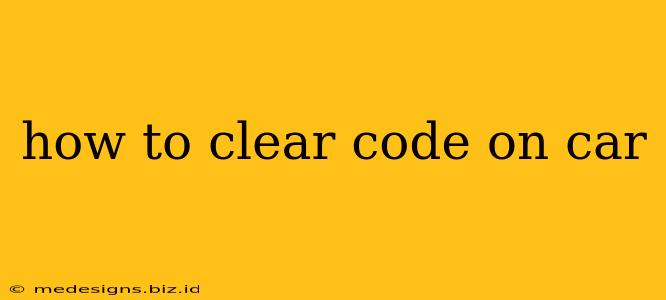Facing a check engine light? Don't panic! Many car issues trigger diagnostic trouble codes (DTCs), often referred to as "codes," which illuminate the check engine light. While a professional mechanic is always recommended for serious issues, understanding how to clear these codes can be a valuable skill, especially for minor problems or after completing repairs. This guide explains how to clear codes on your car, covering various methods and important considerations.
Understanding Car Codes and the Check Engine Light
The check engine light isn't just a pesky annoyance; it's your car's way of signaling a potential problem. The light itself doesn't tell you what the problem is, only that something needs attention. The codes stored in your car's computer are the key to diagnosing the issue. These codes are usually a combination of letters and numbers, each representing a specific fault.
Why Codes Appear:
- Sensor malfunctions: Oxygen sensors, mass airflow sensors, and others can malfunction and trigger codes.
- Loose gas caps: Surprisingly, a loose or faulty gas cap can trigger a code.
- Engine problems: More serious engine issues like misfires, faulty ignition coils, or catalytic converter problems can also activate the check engine light.
- Other issues: Problems with the transmission, ABS system, or other components can trigger codes.
Types of Codes:
- Generic (P-codes): These codes are standardized across many makes and models.
- Manufacturer-specific codes: These codes are unique to specific car brands.
Methods to Clear Car Codes
There are several ways to clear your car's codes, ranging from simple DIY methods to using professional tools.
Method 1: Disconnecting the Battery
This is the simplest method, but it's also the least precise. Disconnecting the battery will often clear the codes, but it won't diagnose the underlying problem.
How to do it:
- Disconnect the negative (-) terminal first. Use a wrench to loosen the bolt and carefully remove the cable.
- Wait for at least 30 minutes. This allows the car's computer to fully reset.
- Reconnect the negative terminal. Then reconnect the positive (+) terminal.
- Start the engine. The check engine light might remain illuminated for a short while, or until the car's computer completes a drive cycle (typically several miles of driving). If the problem persists, the light will likely return.
Caution: This method might reset other settings in your car, such as radio presets.
Method 2: Using an OBD-II Scanner
An OBD-II (On-Board Diagnostics II) scanner is a more sophisticated tool that allows you to read and clear codes precisely. These scanners vary in price and features. Some basic scanners just read and clear codes, while others offer more advanced diagnostic capabilities.
How to use it:
- Locate your car's OBD-II port. This is usually under the dashboard, often near the steering column.
- Plug in the scanner. Follow the manufacturer's instructions for your specific scanner.
- Read the codes. The scanner will display the DTCs stored in your car's computer.
- Clear the codes. Use the scanner's functionality to clear the codes.
- Check for recurring codes. Drive your car for a while and monitor whether the codes reappear. If they do, the underlying issue remains.
Advantages of OBD-II scanners: Provides precise codes for better diagnosis.
Method 3: Professional Mechanic
For persistent or complex problems, a professional mechanic is the best option. They have the experience and tools to accurately diagnose and repair the underlying problem, ensuring your car's safety and reliability.
When to Clear Codes and When Not To
When to clear codes:
- After successfully repairing a diagnosed problem.
- After replacing a sensor or other component.
- If the check engine light is triggered by a minor, temporary issue (like a loose gas cap).
When NOT to clear codes:
- If you don't know the cause of the check engine light. Clearing codes without addressing the underlying problem can mask a serious issue.
- If the check engine light is accompanied by other symptoms, like unusual noises, poor performance, or overheating.
Important Note: Clearing codes doesn't fix the underlying problem. It simply turns off the check engine light. If the issue persists, the light will likely reappear. Always address the root cause of the problem to prevent further damage and ensure your car's safe operation.
